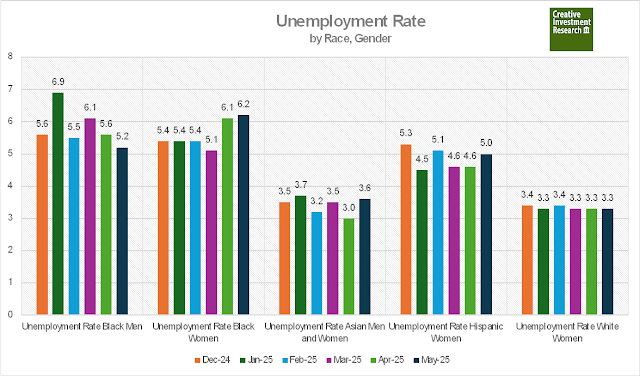Forecast (Black Women): 6.4%
Actual (Black Women): 6.2%
We accurately predicted a rise in the unemployment rate for Black women, but the increase was less severe than expected. The direction of the rate for Black women validates our concerns, even though the rate itself came in below our projection.
Key Takeaways from the Data
-
Unemployment Among Black Women:
-
Rose to 6.2% in May 2025, up from 6.1% in April: Still notably elevated and well above the national average, indicating continued labor market fragility for this demographic.
-
-
Labor Force Participation:
-
Participation among Black individuals declined slightly—from 62.1% to 62.0%—reflecting growing discouragement and withdrawal from the labor force.
-
-
Employment Level:
-
Modest gains in overall employment helped cushion what might have been a more dramatic rise in the unemployment rate. However, the nature of this job growth—its quality, sector concentration, and sustainability—remains a concern.
-
-
Forecast Projection Factors:
Our original projection of 6.4% was informed by:-
The April loss of 106,000 jobs by Black women.
-
Rollbacks in DEI initiatives across the public and nonprofit sectors.
-
Private sector layoff trends, especially in tech and services, as reported in Quartz. The Challenger, Gray & Christmas report noted a 92% increase in job cuts in May compared to April, driven heavily by cuts in the tech and professional services sectors—industries where recent DEI hiring gains for Black women had been concentrated.
-
We expected these structural job cuts to translate into higher short-term unemployment. While they likely had an impact, offsetting gains elsewhere—possibly seasonal or temporary—helped mitigate the rise.
-
Interpretation
This 6.2% figure underscores the volatility of ethnic group unemployment numbers (Asian unemployment increased dramatically), the unevenness of the recovery and the precarious position of Black women in the labor force. Despite modest job gains, many Black women remain locked out of stable, long-term employment opportunities. The data also highlights how quickly small changes in hiring can alter outcomes in such a volatile and vulnerable segment of the workforce.
Policy Implications
-
Retention and Advancement Matter: Job growth alone is not enough. Quality, stability, and upward mobility must be emphasized—especially in sectors where Black women were recently recruited under DEI efforts now being reversed.
-
Outlook: Without targeted support, the unemployment rate for Black women may still climb to 6.4% or higher this summer, particularly as temporary hiring subsides and budgetary constraints impact state and local employment.
